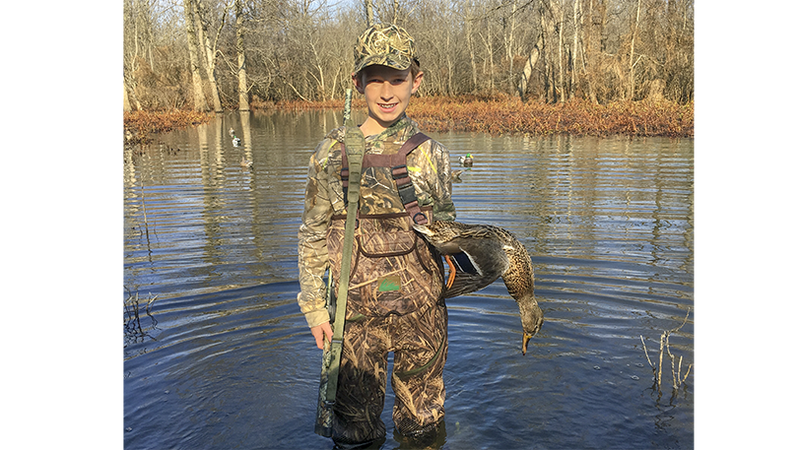First youth waterfowl hunt of Arkansas’s 2018-19 season Saturday
ON 11-28-2018

Nov. 28, 2018
Randy Zellers
Assistant Chief of Communications
LITTLE ROCK – The ducks have a brief rest between the segments of duck hunting season, but on Saturday, the first of two youth waterfowl hunts will have hunters back in the woods in search of Arkansas’s premiere game species.
Young duck and goose hunters benefit from the special hunts, which were created more than a decade ago by the Arkansas Game and Fish Commission with the blessing of the U.S. Fish and Wildlife Service. Each hunt gives youths the chance to sharpen their duck hunting skills while under the supervision of an adult. Only hunters 15 and younger may hunt ducks, geese, coots and mergansers, allowing mentors to focus solely on teaching the next generation how to set up, call and be successful hunting waterfowl. It’s also a great time to instill those unwritten rules of waterfowling to young hunters and show them that waterfowl hunting isn’t about bagging a limit of ducks the quickest or seeing who can take a picture of the biggest pile of birds. It’s about sharing the experience.
This year’s youth hunts will follow the same format as the last few years, with one day being this Saturday, and a second hunt scheduled for Feb. 2, 2019, after regular duck season has closed.
“We’ve tried a two-day hunt at the end of the season, a two-day hunt during the first split in duck season segments, and our current system of two single-day hunts,” said Brad Carner, chief of wildlife management for the AGFC. “There are some who prefer a single two-day hunt, and some who prefer multiple one-day hunts, and all have their merit. But we have stayed with two one-day hunts to increase the opportunity for youths to participate.”
By breaking up the hunt into two days at different times of year, the AGFC is hoping to increase the chances of good conditions being available for one of the hunts. In some years, early water and cold weather combine to create good duck hunting in December. During other years, the ducks do not arrive in great numbers until late winter. Two hunts offers two chances to catch the right combination of weather and water.
“Two hunts also increases the likelihood that youth will be available to participate,” Carner said. “I have a son who I take hunting, and with all the other distractions competing for attention, it can be hard to find two days in a row that don’t get filled with sports, and other extracurricular activities.”
Although the spirit of the hunt is to allow for more time between a mentor and youth hunter, youths who have completed a hunter education course may hunt on their own if their parent or legal guardian feel comfortable allowing them to do so. Youths who have not completed a hunter education course must be accompanied by an mentor who is 21 years or older. Mentors may not shoot any waterfowl, but may set decoys, retrieve downed game and call for the youths.
Wildlife management areas can be the ticket to some excellent opportunities during youth waterfowl hunts. Some regulations are temporarily lifted during the hunts to increase the odds of youth hunters having a successful trip.
“All day hunting is allowed on our WMAs during youth hunts,” Carner said. “It gives young hunters more time to find some birds, and it makes it possible for some hunters to squeeze the hunt in on days when they may have prior commitments. You may have a basketball game or family event during the morning, but still be able to get out and enjoy a hunt afterward.”
Carner says the one-day departure from shooting times does not impact the movement of birds much, as there are four days after the hunt for ducks to settle down before the next hunting season segment begins.
“I hear a lot about overcrowding on our popular duck-hunting WMAs, but I’ve rarely seen more than a handful of hunters and mentors when I get out with my son on public land during the youth hunts,” Carner said. “Last year, we had a hunt of a lifetime during the February youth hunt on a very popular duck-hunting area and hardly saw another hunter. He never filled out his six-bird limit because we couldn’t see anything but mallards, but we could have easily taken 20 birds that day on public land and we had the place to ourselves.”
The amount of shotgun shells a youth hunter may carry is not regulated during the youth hunts on those WMAs that have shell limits. Ethical shot selection is one of the values mentors should teach, but young hunters may have underdeveloped shooting skills, so it’s wise to carry a full box of shells in case the young hunter has a poor shooting streak.
“It doesn’t just have to be a youth hunt to bring a young hunter along, either,” Carner said. “I look at it like I have 62 ‘youth hunt’ opportunities in my season to help show my son how great of an opportunity we have to enjoy duck hunting on public land here in Arkansas.”
Recent News

AGFC Commissioner Meeting Notice
Apr. 16, 2024
Subscribe to Our Weekly Newsletter E-mails
Don’t miss another issue. Sign up now to receive the AGFC Wildlife Weekly Newsletter in your mailbox every Wednesday afternoon (Waterfowl Reports are published weekly during waterfowl season and periodically outside the season). Fishing Reports arrive on Thursdays. Fill in the following fields and hit submit. Thanks, and welcome!

